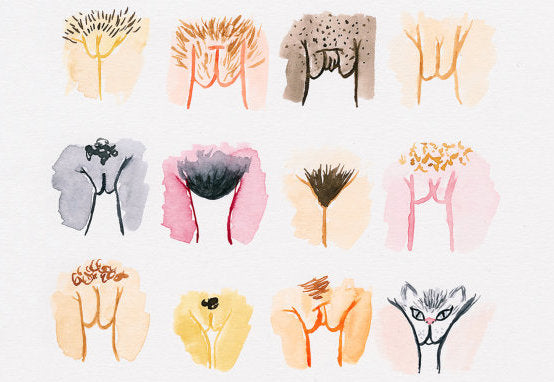Paying Homage to the Hoo-Ha: Vagina Art Through the Ages

Vajayjay. Hoo-ha. Flower. Pocketbook. The vagina has been called many things. Just like it has a variety of names, there have been many artists who have paid homage to the vagina in tasteful ways since man has been known to walk the Earth.
Let’s talk a wondrous wander through the wonderful world of vagina art:
Ancient Art

One of the oldest pieces of art ever created was an image dated circa 35,000 BC. Priorities for men during this time were hunting and reproducing. So, it makes perfect sense that men living in Stone Age Pleistocene would spend time carving an object of their favorite past times in a rock. Being that it was etched in stone, much debate has been made about whether this was an actual depiction of a vagina since there is not much detail other than a circle with a slash through it.
Another piece from this time period is the Venus of Hohle Fels, found circa 37,000 BC in Germany. This full body female depiction leaves no question in the mind about what is being depicted. Made entirely of ivory, it is believed that this relic was used in ancient fertility rituals.
Classical Art

Many European museums hold classical pieces of vagina art. Women would pose nude for these scandalous pieces, for a shocking reveal and dinner parties among the most distinguished of guests. These marble pieces were also depictions of goddesses as perceived through the imaginative eye of an artist.
While some of the vagina of this art showed full bush coverage, most of it is marked by being hairless, a trend notable in much of the Grecian vagina art. One of the most famous pieces of vagina art was created by Leonardo Da Vinci during the renaissance as a way to reconnect a restrictive and conservative society. His piece highlights the beauty in design as well as touched on scientific aspects of the vagina which make it a true work of art.
Modern Art

The dawning of the 20th century saw a major shift in vagina art. With the popularity of such artists like Georgia O’Keefe, the art became more detailed. Some artists depicted the vagina in surreal scenes with other objects, the vagina being the center piece and clearly defined. The women’s rights movements of the 1960s brought forth vagina art with political overtones.
These gestures were different from the erotic depictions of the decades prior. It was not uncommon for feminist to have performance pieces showcasing their exposed lady regions. One such piece, Interior Scroll by Carolee Schneemann, was a display of the artist standing on a table, her body painted in mud, as she pulled a scroll out of her vagina and began reading from it. It’s no wonder, then, that it’s one of her most famous and memorable pieces.
While many modern pieces have borderline pornographic classifications, there are some artists who still work to display the beauty of feminism and the intricacy in design of female genetalia. With gender issues coming to the forefront, androgynous art depicting both male and female parts have joined the ranks of vagina art classification. More than anything, much of the modern vagina art has been used to send clear and definite messages on femininity, stereotypes, and gender roles. A quick search of Etsy yields many incredible results.
Although not listed among one of the world’s wonders, the fact that the vagina has long since been the object of many artistic masterpieces indicates exactly how revered the vagina is. In a time when women are often degraded, seeing an artist depict the vagina in a way that shows its beauty can be refreshing and breath-taking.
Photos courtesy of Hilde Atalanta on Etsy (featured image), Smithsonianmag.org, Royalcollection.org and georgiaokeeffe.net,
0 comments